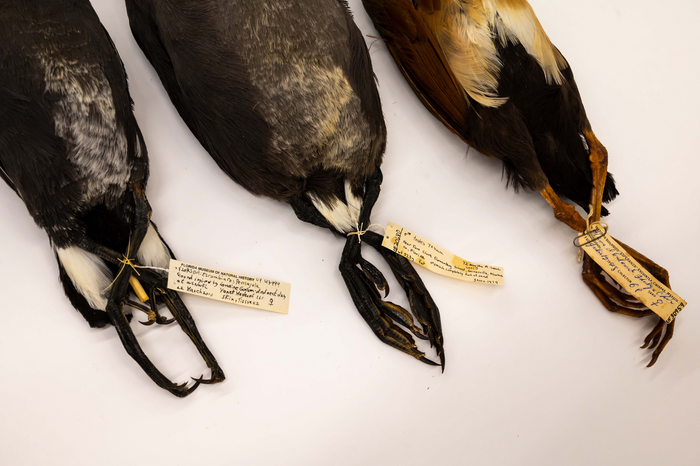There are more than 1,000 natural history museums around the world, each tasked with studying and preserving a portion of our planet’s natural and cultural heritage. Notes From Nature is an online platform that allows anyone with an internet connection to advance that mission by helping move valuable specimen data out of museums and into the hands of scientists.

Credit: Florida Museum of Natural History photo by Jeff Gage
There are more than 1,000 natural history museums around the world, each tasked with studying and preserving a portion of our planet’s natural and cultural heritage. Notes From Nature is an online platform that allows anyone with an internet connection to advance that mission by helping move valuable specimen data out of museums and into the hands of scientists.
This month, the platform is celebrating its 10th anniversary and the many people who’ve helped ensure its success. Over the last decade, volunteers have transcribed information from more than 4.7 million specimens, making a significant dent in the backlog of objects that are stored in museums but for which there is no information available online.
“We have had such committed volunteers and networks of museum folks who care about this effort,” said Robert Guralnick, curator of biodiversity informatics at the Florida Museum of Natural History and one of the original founders of Notes From Nature. “It’s become this amazing place to try new things and see how they can work, to learn by doing. It sometimes doesn’t go how we expect, but I think those failures have been as interesting and worth exploring as our successes.”
The mission to catalog Earth’s biodiversity has resulted in an inconceivably large number of specimens. Just 73 of the largest museums contain 1.1 billion objects, with billions more collectively housed in smaller institutions. In isolation, each specimen has only limited utility, but combined, scientists and other stakeholders can use them to answer critical biodiversity questions and assess how well species adapt or succumb to Earth’s rapidly changing climate.
The large-scale analysis of specimen data is relatively new, made possible by the advent of digital repositories at the turn of the century. While museums have existed for hundreds of years, the online platforms that allow them to share information about the specimens they’ve amassed have only been around for a few decades. This lag has created a digital bottleneck, slowing the pace of scientific discovery.
There are two steps to digitizing museum specimens, starting with photography. Imaging is cumbersome but relatively straightforward and can even done using an assembly line. In 2015 and 2016, the Smithsonian National Museum of Natural History photographed more than 250,000 of its fern specimens by placing them on a conveyor belt, and the rest of its plant collection soon followed. For museums that lack this resource, photographing specimens can be an arduous process, one that people must be complete onsite.
In the second step, specimen labels containing vital information about the identity of the object and when and where it was collected have to be painstakingly transcribed. This becomes especially difficult with older labels, which were often handwritten in cursive and with varying degrees of legibility. This makes it impossible for object recognition software to accurately transcribe them. For that, you need people with keen eyes, diligence and patience. Transcription is by far the most time-consuming step in the digitization process, but it’s a task anyone can work on anywhere in the world.
Yet 10 years ago, transcription efforts were siloed within individual institutions, carried out by small groups of staff, students and volunteers unequal to the task of bringing large collections entirely online.
Several researchers simultaneously recognized this problem and independently arrived at the same solution. What eventually became Notes From Nature in 2013 was spurred by a project called Old Weather, in which volunteers transcribe ship logs from the 19th and 20th centuries to help scientists model past and future climate change.
“We thought it was such a good idea we wrote a short proposal to a group that was funding efforts to start citizen science projects. It turns out two other groups did as well, and we all decided to coalesce under the Notes from Nature banner,” Guralnick said.
Notes From Nature was founded on the central idea that citizen scientists could help exponentially increase the rate of discovery by transcribing museum data without even having to leave their house. Funded by the National Science Foundation, the platform connects people to the wonders of the natural world. Since its inception, more than 18,000 individuals have contributed to the project, transcribing and annotating a menagerie of natural history specimens, including flowering plants, butterflies, amphibians, beetles and parasites.
Several studies have been published using Notes From Nature transcriptions, including one that explains how butterfly wings have evolved into a myriad of seemingly improbable shapes and sizes while still maintaining the power of flight.
Staff and laboratories that help maintain the platform have also hosted dozens of online and in-person events, such as transcription blitzes and educational activities for students in middle school and above.
As the platform grows and improves, the wonder of discovery continues to be the motivation that carries it forward, of which the natural world has an inexhaustible supply.




